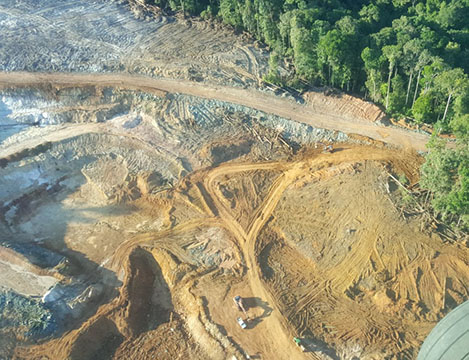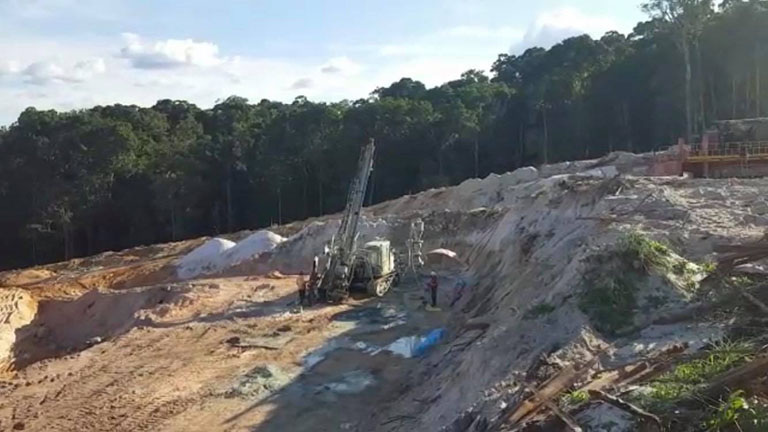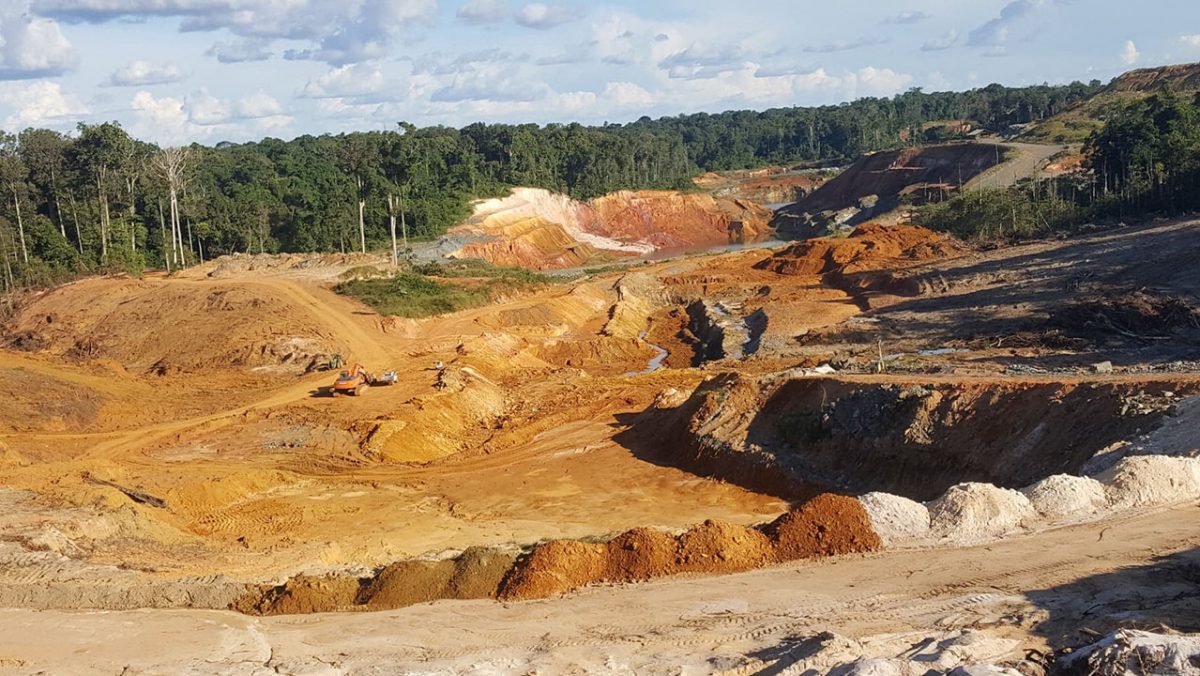The Board of Australian gold mining company, Troy Resources Ltd will on Sunday decide the future of its Region 7 operations, even as Chief Executive Officer Ken Nilsson said that they would need about US$5M per month to sustain it and hinted at a possible short-term scaling down.
“There are a number of factors. Next week everybody will know because I have a Board meeting on Sunday. What is possible is everything going back to where we were, doing it in a more focused manner or do nothing; those are the three options,” Nilsson, yesterday told reporters during a tour of its Karouni mine in Cuyuni/Mazaruni.

“Doing nothing is not a particularly good one because where we are is costing us about US$40,000 per day and no one can survive spending that money every day without getting an income and obviously we can’t afford that, so a decision is critical,” he added.
With approximately 450 workers as at September, some 95% of those being Guyanese, Nilsson said that for the past six months the company had been putting a strain on itself as it did not want to terminate the services of any employee. The secondary plant has been kept in operation because Nilsson said that to totally shut down a plant while having plans to start it up again would be costly when that time comes.

With operations only in exploration mode, some 137 employees have been kept on and are being paid. Nilsson said that to get back to all three stages of operations would require input of “about ideally US$5M but we work with about US$4M per month”. However, he explained that it was not sustainable and a plan had to be worked out to look at the business interests of the company, lest it starts falling into deficits and becomes unsustainable for future operations.
He hopes with a plan he proposes to the Board on Sunday that “operations can be back to normal”.
Explaining that the company’s current state was only compounded by the stoppage of work following the death of a geologist, he explained that lack of finances was one aspect that also hindered development. “Over the last six months the company has struggled because of very poor developments and we need to get some of our resources back into production. If I was the way most people are, I would have terminated about 100 persons about three months ago. I chose to keep them on and paid the penalty; paying wages to people who were not really working. Everybody that works here knows this. Everybody was expecting to get laid off but I didn’t do that,” he said.
“I said ‘we will need these guys eventually and paid the price. What I am doing is we still need to get our flow of ore back into some normal state where you can see that you are making enough money and that I am working on at this point and time. This in addition to having a month taken out [of work] with everything that happened,” he added.
Cease order
The company was issued with a cease order on October 10 by Minister in the Ministry of Social Protection with responsibility for Labour, Keith Scott following the death of geologist Ryan Taylor. Taylor died on October 8 while working on the construction of a “bench” in a mining pit. A slippage occurred, which led to him falling and being covered by the rubble. The report on that death has not been concluded yet by the government and the company said that while it has done its own, it will await the government’s finding.
The company has also received the green light from the Guyana Geology and Mines Commission (GGMC) to restart their operations. The clearance was presented to Troy last Wednesday, after the GGMC found that there was no impediment to their resumption of operations.
Troy suspended operations on October 15 after what it said was a knee-jerk reaction by Scott, who on October 10th ordered a cessation of all mining activities.
Troy in its October 15 statement had said that the cease order had come as a surprise to the Company since the ban included all mining areas rather than isolating the area where the incident occurred.
While the order came in the wake of the death at the site, the company was critical of Scott’s action, arguing that the stop order was inconsistent with normal protocol in such situations. Normal protocol, it argued, is to cordon off the area of the incident, being the Hicks 1 Extension Trench, a process the company had already undertaken immediately after the death. Having taken this action, Troy expressed surprise at the cease order, which covered all mining areas including the Smarts 3 and Larkin Pits, which are not where the fatal accident occurred.
Sources told Stabroek News that the company petitioned government for a reprieve after explaining that a cease order would mean that its entire operations had to be halted.
Some employees have complained bitterly about the actions by the company, saying that it was without warning that they were told of the layoffs.
Employees had said that they had not yet been contacted by the company on the way forward but understood that they would not be paid for the period they have been laid off.
The CEO yesterday said that the company would not pay the employees for the period they were laid off and did not know if their union would give them any compensation.
Retrain
He pointed out that he will also explain to the Board that to retrain employees if they are laid off will cost a lot since much investment, financial and otherwise, has been put in to get the company to where it is. “They have an option if they want to work for us. We can’t force anybody but we spent massive amounts to train them. We brought specialist guys out from Australia. It is a high investment. If we are going to have to go back and do training”, he said.
“We have had more people than we need but we need those people to do our other creek [and other operations] so that is where the juggling comes in. If you have a business and it shuts down, you have to have a good business plan to open back up. That is what we have been working on for the past three weeks for the Board. I think we have a business plan to make sense and that is what we are putting for the Board to approve,” the manager added.
The CEO said that persons here don’t understand the magnitude of the safety input and wants to assure that they “are not operating like pork knockers…In Guyana, when we talk about mining, everybody thinks it is about alluvial mining,” he said.
In 2013 the company bought the Karouni project from another Australian company, Azimuth Resources Ltd and had been operating it since
Troy’s third quarter 2019 gold production figure was the lowest in recent quarters, according to the company’s report. The output for the June 2019 quarter was 11,567 ounces, for the March, 2019 quarter 13,333 ounces and 14,227 for the quarter ended December, 2018. The third quarter of 2019 gold output was 10,042 ounces.
Gold sold for the last quarter was also sharply down. The Troy figures showed that gold sold by the company amounted to 8,783 ounces compared to 12,545 ounces in the preceding quarter. For the quarter just ended, Troy’s All-In Sustaining Cost (AISC) was US$1,374 per ounce while the gold price realized was US$1,465 per ounce.
While he would not go into detail, Nilsson said that a local group here has seen it being put under pressure. “The problem is we have had a lot of pressure on Troy from certain interest groups that had been attacking from every conceivable quarter, and that is as much I would like to say. That put us under a lot of pressure and they also have a lot of good connections within government,” was all he would say.
But he hopes that he will have good news to bring to the Guyanese people on Monday as he underscored that not only the company is losing revenue but about U.S$3M of that U.S$5M per month it spends is with local contractors. The 8% royalty rates too he said will be affected and he anticipates that the Board will listen to the proposals he makes and give the company the opportunity to implement those measures.
“In a sense, next week we will have to do something. We are operating under a system which allows us to stand people down for various reasons. That has a timeline and that timeline runs out next week. So before then, we have to have something and can say this is how we are trying to operate. At the end of the day, it sits with the Board of Troy…and that is when the decision will be made,” he said.
“The Board is more intrigued about making sure that they are planning for the future and we reach …it is simple as that. This is a business and Troy in Guyana is a proud company it is nothing else…,” he added.






